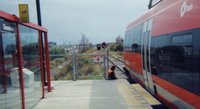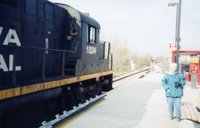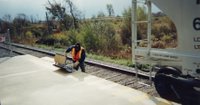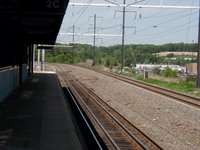Track Sharing with the O-Train
One issue that has driven up the costs of the LRT Project is the city's insistence that the entire North-South line must be double-tracked, and even triple tracked, where freights would share the corridor. Many people knowledgeable on the subject think this is not necessary, and that some areas can be single tracked with switches and signalling in place to control the flow of trains. In those sections where freight trains would share the corridor, double track would suffice, but only one of the two tracks would need special treatment to allow freights to pass, as described below.
Timothy Lane explains:

First one, is a photo I took of an O-Train about to depart from Greenboro, on Oct 31, 2002.
A freight locomotive in the distance is waiting for the O-Train to leave, and the Rail Term worker beside the platform, to flip up the platform extenders.
The locomotive is returning to Walkley Yard, with a car that has undergone testing, from the NRC's Centre for Surface Transportation Technology, near Lester Rd.
Coincidentally, it's the same car that the CSTT has on their website, as an example of the work they do: Link

This one shows the Ottawa Central locomotive passing the Greenboro platform on its way back to Walkley Yard, with a car that has been tested at the NRC's Centre for Surface Transportation Technology, near Lester Rd.
Notice that the platform extenders have been folded back, to give more clearance for the freight train, which is wider than the O-Train.
Notice how the lady in the picture is scrunched up against the bench, to get as far away from that monster as she can!

This one shows a freight car, towed by an Ottawa Central locomotive, passing the Greenboro platform on its way back to Walkley Yard. The car had been tested at the NRC's Centre for Surface Transportation Technology, near Lester Rd.
The Rail Term worker is putting the platform extenders back down again, to be ready for the next O-Train to arrive.
Total elapsed time from when the O-Train left, extenders up, freight train passes, extenders back down to receive next O-Train: Four (4!) minutes!
Now, to be fair, when the O-Train is extended farther south, this wouldn't work anymore. The freight train would occupy the O-Train track for too great a distance, and too long a time, on its way from Walkley Yard/Greenboro to Lester road.
The freight car moves would probably have to be done at night, when the O-Train isn't running. However, that's quite an improvement over what "They" (City planners) were telling the NRC, "Oh, by the way, freight train access to your Centre for Surface Transportation Technology is to be abandoned."
The Future: Track Sharing with the O-Train

Here is a less labour intensive way to do track sharing between passenger trains & freight trains. The photo (by Normand Levert) is taken at an AMTRAK high level platform at the New Carrolton Station outside of Washington, DC.
The station is also used by commuter trains.
A gantlet track is installed in front of the platform, to give freight trains the needed extra clearance with the platform edge.
Longer ties are put down, say ten footers instead of the standard eight foot ties.
A second set of rails is placed on these ties, two feet away from the rails the passenger trains use.
A set of switch points at each end of the gantlet sends the freight trains onto the outside set of rails, keeping the wider freights away from the platform.
The switch points are controlled by a remote control electric switch motor, thus eliminating the need to have a worker there to throw the points.
This arrangement is now standard on CSX railroad, one of the biggest eastern US railroads, wherever their freights have to pass a passenger platform.
It is used, or will soon be used, at many other locations around the U.S.
This method would work equally well on our new, improved, LRT system, both south from Walkley Yard to the NRC, and north to the Prince of Wales bridge to Gatineau.
Of course, the overhead wire will have to be 23 feet above the track, to clear the latest, largest freight cars.
Not the 20 feet that "They" are specifying. "Their" design will prevent the new LRT system from not only sharing track with freight trains, but the LRT won't ever be able to cross another rail line at grade.
Grade separations would be required EVERYWHERE, which will make any further LRT expansion east, west, or anywhere, much more difficult & expensive.
Only one of the two LRT tracks would need gantlet track, since there should never be a need for TWO freight trains to be on the line simultaneously.
Unless, of course, the coming Hubbert Peak in world oil production REALLY forces a lot more freight back on the rails!
Regards,
Tim


<< Home